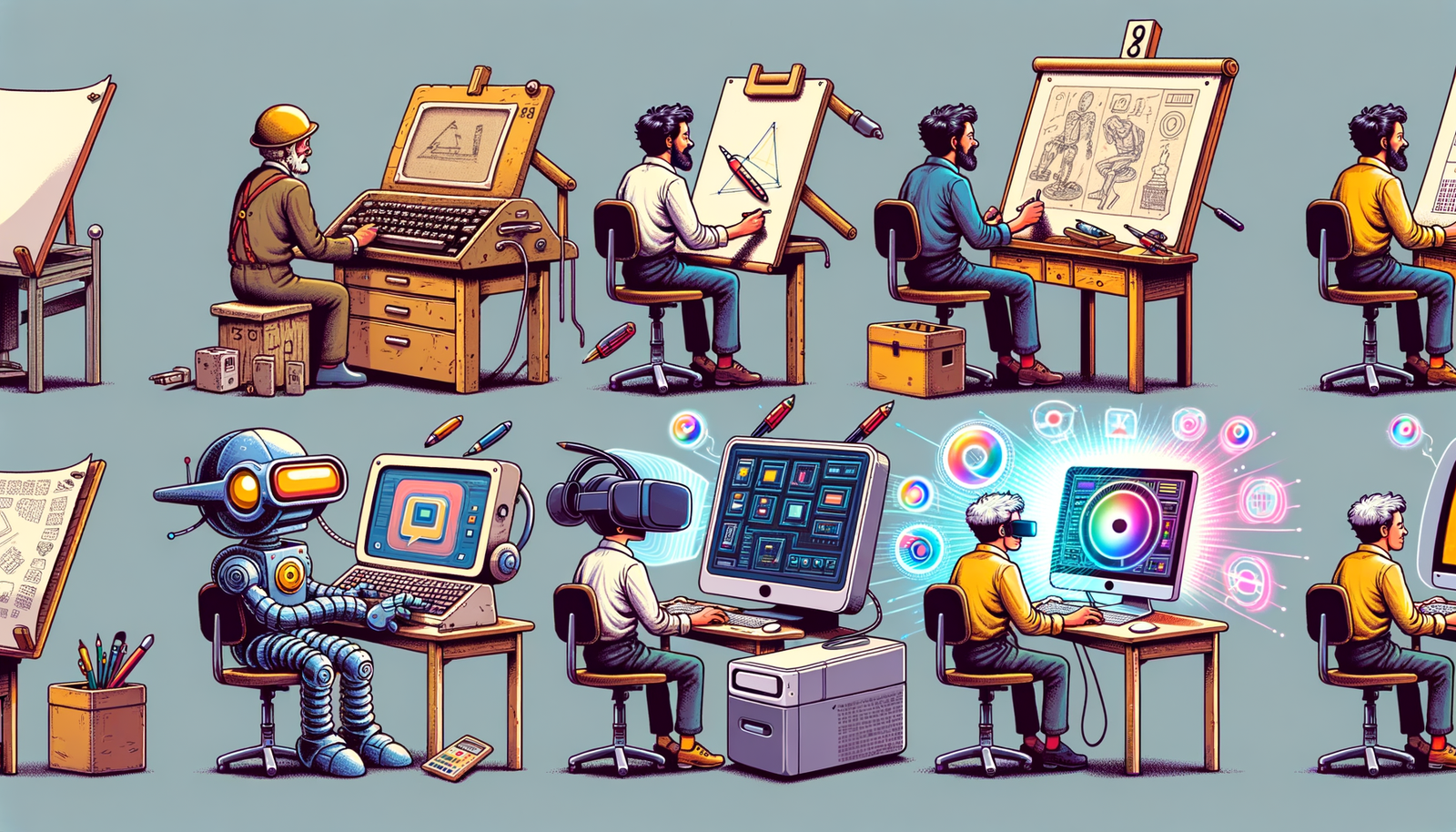Your Cart is Empty
Customer Testimonials
-
"Great customer service. The folks at Novedge were super helpful in navigating a somewhat complicated order including software upgrades and serial numbers in various stages of inactivity. They were friendly and helpful throughout the process.."
Ruben Ruckmark
"Quick & very helpful. We have been using Novedge for years and are very happy with their quick service when we need to make a purchase and excellent support resolving any issues."
Will Woodson
"Scott is the best. He reminds me about subscriptions dates, guides me in the correct direction for updates. He always responds promptly to me. He is literally the reason I continue to work with Novedge and will do so in the future."
Edward Mchugh
"Calvin Lok is “the man”. After my purchase of Sketchup 2021, he called me and provided step-by-step instructions to ease me through difficulties I was having with the setup of my new software."
Mike Borzage
Design Software History: Evolution of Design Software: From Sketchpad to AI-Driven Innovations
August 07, 2024 6 min read


1. Introduction: The Genesis of Design Software
The evolution of design software is a testament to the rapid technological advancements and growing needs of various industries. From its humble beginnings in the mid-20th century, design software has become an indispensable tool in modern engineering, architecture, and numerous other fields. This journey has been marked by the contributions of visionary pioneers and innovative companies who have shaped the landscape of design software.
Design software's historical development is not just a tale of technological progress but also a story of creativity and human ingenuity. The contributions of key pioneers and companies have been monumental in transforming ideas into practical solutions that have revolutionized how we approach design and manufacturing today.
2. Early Innovations and Pioneers
Ivan Sutherland and the Revolutionary Sketchpad (1963)
One of the most significant milestones in the history of design software was the creation of **Sketchpad** by **Ivan Sutherland** in 1963. Sketchpad is widely regarded as the world's first graphical user interface and an early form of computer-aided design (CAD) software. It introduced the concept of manipulating objects graphically on a screen, laying the groundwork for future CAD systems.
The significance of Sketchpad lies in its innovative use of graphical interaction and constraint-based drawing, which allowed users to create and manipulate geometric shapes using a light pen. This breakthrough not only demonstrated the potential of graphical user interfaces but also had a profound impact on subsequent CAD systems, influencing the development of more sophisticated design software.
Patrick Hanratty and His Contribution to Commercial CAD Systems
Another pioneer in the field of design software was **Patrick Hanratty**, who is often referred to as the "father of CAD." Hanratty's journey in design software began with the development of **DAC (Design Automated by Computer)** in 1957. DAC was one of the earliest attempts to use computers for automated design and drafting.
In the 1970s, Hanratty continued his contributions by creating **ADAM (Automated Drafting and Machining)** software, which became one of the first commercially successful CAD systems. ADAM's innovative features, such as interactive graphics and the ability to generate machine code directly from CAD drawings, set the stage for the widespread adoption of CAD technology in various industries.
Role of MIT in Early Design Software Development
The **Massachusetts Institute of Technology (MIT)** played a pivotal role in the early development of design software. The contributions from MIT's **Electronic Systems Laboratory** were particularly noteworthy. Researchers at MIT were at the forefront of innovations in computer graphics and geometric modeling, which laid the foundation for many of the design software tools we use today.
MIT's work in early computer graphics, such as the development of the **Whirlwind** computer and the **TX-2** system, provided a platform for pioneering research in graphical interaction and geometric modeling. These early innovations were instrumental in shaping the trajectory of design software and establishing MIT as a hub of technological advancement.
3. Transition from 2D Drafting to 3D Modeling
Evolution from 2D to 3D Modeling Techniques
The transition from 2D drafting to 3D modeling marked a significant leap in the capabilities of design software. Early CAD systems primarily focused on 2D drafting, which had inherent limitations in representing complex three-dimensional objects. As technology progressed, the need for more advanced modeling techniques became apparent.
One of the key breakthroughs in this transition was the introduction of solid modeling. Solid modeling allowed designers to create and manipulate three-dimensional objects with greater precision and accuracy. Unlike 2D drafting, which relied on lines and shapes, solid modeling used mathematical representations of volumes, enabling more realistic and detailed designs.
Development and Impact of SolidWorks and Pro/ENGINEER
Two of the most influential software in the realm of 3D modeling are **SolidWorks** and **Pro/ENGINEER**. These tools pioneered parametric and feature-based modeling, which revolutionized the way designers approached 3D modeling.
- SolidWorks: Developed by **Dassault Systèmes**, SolidWorks introduced a user-friendly interface and powerful modeling capabilities that made it accessible to a wide range of users. Its parametric modeling approach allowed designers to create models that could be easily modified by changing parameters, leading to more efficient design iterations.
- Pro/ENGINEER: Created by **PTC (Parametric Technology Corporation)**, Pro/ENGINEER was one of the first CAD systems to fully embrace parametric and feature-based modeling. It provided advanced tools for creating complex assemblies and detailed designs, making it a favorite among mechanical engineers and product designers.
Mathematical Foundations and Geometric Modeling
The development of 3D modeling techniques was underpinned by several mathematical foundations, particularly in the areas of geometric modeling and computational geometry. Two key concepts that played a crucial role in modern CAD systems are **NURBS (Non-Uniform Rational B-Splines)** and **Bezier curves and surfaces**.
- NURBS: NURBS are mathematical representations of 3D geometry that provide great flexibility and precision in modeling complex shapes. They are widely used in CAD systems for creating smooth and accurate curves and surfaces. The ability to modify the shape of NURBS by adjusting control points and weights makes them invaluable in design applications.
- Bezier Curves and Surfaces: Introduced by the French engineer **Pierre Bézier**, Bezier curves and surfaces are fundamental tools in computer graphics and CAD. They allow designers to create smooth and continuous curves and surfaces, which are essential for modeling complex geometries. Bezier curves and surfaces are widely used in automotive and aerospace design, where precision and smoothness are paramount.
4. Modern Advances and Future Directions
Impact of Design Software on Various Industries
The impact of design software on various industries cannot be overstated. From architecture to aerospace, these tools have transformed the way we conceptualize, design, and manufacture products. Some of the key software and their influence on different industries include:
- AutoCAD: Developed by **Autodesk**, AutoCAD has been a cornerstone of architectural design for decades. Its intuitive interface and powerful drafting tools have made it the go-to software for architects and engineers. The ability to create detailed 2D and 3D drawings has streamlined the design process and improved collaboration among stakeholders.
- CATIA: Created by **Dassault Systèmes**, CATIA is a comprehensive CAD software that serves as the backbone of aerospace design. Its advanced modeling capabilities and integration with other engineering tools make it ideal for designing complex aerospace components and systems. CATIA's impact on the aerospace industry has been profound, enabling the development of cutting-edge aircraft and spacecraft.
Integration with Emerging Technologies
The integration of design software with emerging technologies has opened up new possibilities for innovation and efficiency. Some of the key areas where design software is making significant strides include:
- Additive Manufacturing and Rapid Prototyping: The advent of 3D printing has revolutionized manufacturing, and design software plays a crucial role in this process. CAD models can be directly used to create physical prototypes using additive manufacturing techniques, enabling rapid prototyping and reducing the time and cost associated with traditional manufacturing methods.
- Cloud Computing and Collaborative Design Environments: The rise of cloud computing has transformed the way design teams collaborate. Cloud-based design software allows multiple users to work on the same project in real-time, regardless of their location. This has improved collaboration, reduced version control issues, and accelerated the design process.
- AI and Machine Learning in Design Software: Artificial intelligence and machine learning are increasingly being integrated into design software to enhance its capabilities. AI algorithms can assist in tasks such as generative design, where the software generates multiple design alternatives based on specified constraints. Machine learning can also be used to optimize designs and predict potential issues, leading to more efficient and reliable products.
Future Prospects
The future of design software is filled with exciting possibilities, driven by advancements in technology and changing industry needs. Some of the potential future directions for design software include:
- Quantum Computing in Design Software: Quantum computing has the potential to revolutionize design software by providing unprecedented computational power. This could lead to significant improvements in areas such as optimization, simulation, and modeling, enabling more complex and accurate designs.
- Virtual and Augmented Reality for Design Visualization: Virtual and augmented reality technologies are becoming increasingly important in design visualization. These tools allow designers to create immersive environments where they can interact with their designs in 3D. This enhances the ability to identify and address potential issues before physical prototypes are created.
- Sustainable and Smart Design Solutions: As the focus on sustainability grows, design software is evolving to support environmentally friendly and energy-efficient designs. Smart design solutions that leverage data from IoT devices and other sources are also becoming more prevalent, enabling the creation of intelligent and adaptive products.
Also in Design News

Cinema 4D Tip: Lock Framing Early with Cinema 4D Safe Frames and Aspect Overlays
October 30, 2025 2 min read
Read More
ZBrush Tip: Conservative Projection Workflow for Artifact-Free Detail Transfer
October 30, 2025 2 min read
Read More
V-Ray Tip: Bake Static GI into Lightmaps for Real-Time Engines
October 30, 2025 2 min read
Read MoreSubscribe
Sign up to get the latest on sales, new releases and more …


